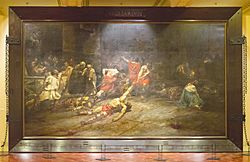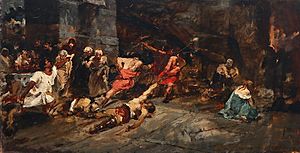Spoliarium facts for kids
Quick facts for kids Spoliarium |
|
|---|---|
| Artist | Juan Luna |
| Year | 1884 |
| Medium | Oil on canvas |
| Dimensions | 4.22 m × 7.675 m (13.8 ft × 25.18 ft) |
| Location | National Museum of Fine Arts, Manila |
The Spoliarium (often misspelled Spolarium) is a painting by Filipino painter Juan Luna. Luna, working on canvas, spent eight months completing the painting which depicts dying gladiators. The painting was submitted by Luna to the Exposición Nacional de Bellas Artes in 1884 in Madrid, where it garnered the first gold medal (out of three). The picture recreates a despoiling scene in a Roman circus where dead gladiators are stripped of weapons and garments. Together with other works of the Spanish Academy, the Spoliarium was on exhibit in Rome in April 1884.
In 1886, the painting was sold to the provincial government of Barcelona for 20,000 pesetas. It currently hangs in the main gallery at the first floor of the National Museum of Fine Arts in Manila, and is the first work of art that greets visitors upon entry into the museum. The National Museum considers it the largest painting in the Philippines with dimensions of 4.22 meters x 7.675 meters.
Other versions
Existing versions of the Spoliarium
Philippine historians Ambeth Ocampo and Santiago Albano Pilar have stated that there are at least four known versions of the Spoliarium that exist with the much larger 1884 version being in the collection of the National Museum of Fine Arts. Two smaller versions are known to exist that are presently in private collections, while the other was commissioned for a Russian nobleman that remains unlocated.
The boceto for Spoliarium
In 2018, a forgotten boceto (study) of the Spoliarium was rediscovered after nearly 125 years. The boceto is considered the earliest version of the work and is dated from 1883, made ascribed on the canvas itself with the words, SPOLIARIVM - boceto LVNA, R[OMA], 1883, making this version the earliest. Based on the literature, the study featured a peculiar signature written by Luna in baybayin script on the canvas's lower right side. The script for the word BU LA[N], was deduced from the Ilocano language for moon, which the artist added only to about four of his known works.
The boceto was last publicly exhibited at the 1893 Exposición Histórico-Natural y Etnográfica at the National Archaeological Museum in Madrid. Further research revealed that its provenance is part of the collection of the Philippine politician Pedro Paterno, a known friend and patron of Luna.
The painting later ended in the ownership of Don Jose Vazquez Castiñeira, a former mayor of Sarria, a municipality in the province of Lugo in Spain for nearly 130 years. It is believed that Paterno having been appointed as the new Director of the Museo-Biblioteca de Filipinas, the paintings were later sold or given to the Vazquez Castiñeiras. Paterno was married to Maria Luisa Piñeiro de Paterno who originated from Galicia, the same area were Vazquez Castiñeiras hailed from.
In 1996, Maria Nuñez Rodriguez, a childless widow of Don Francisco Vazquez Gayoso summoned her relatives into her household able to divide her estate. Included in the said estate were Philippine works of art that included an earlier version of España y Filipinas (1884) by Luna, the Spoliarium study, La Pintura, a work by Luna's contemporary Félix Resurrección Hidalgo, and other Philippine works of art.
The work was subsequently sold for a record price of PHP73.584 million (US$1.36 million) at a Salcedo Auctions' Important Philippine Art sale in the Philippines.
See also
 In Spanish: Spoliarium para niños
In Spanish: Spoliarium para niños



